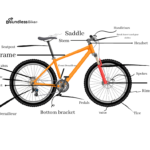Have you ever wanted to learn how to wheelie on a mountain bike? It’s a great skill to have, and it can add a whole new level of excitement to your ride! In this article, we’ll discuss the two different methods of wheelies and give you some tips on how to perform them safely and successfully. So, ready to take your biking skills to the next level? Let’s get started!
How To Wheelie On A Mountain Bike
Learning how to wheelie on a mountain bike can be a fun and useful skill for any rider. Wheelies can help you navigate obstacles, impress your friends, and add an extra level of excitement to your rides. However, wheelies require practice, patience, and proper technique. By following the steps outlined in this guide and practicing in a safe and controlled environment, you can gradually improve your wheelie skills and take your mountain biking to the next level. Remember to always wear appropriate safety gear and never attempt to perform a wheelie beyond your skill level.
Preparation
Before you start practicing your wheelies, it’s important to make sure you’re properly prepared. Here are some key steps to follow:
- Choose the right gear: Start by selecting a bike that’s appropriate for your skill level and the terrain you’ll be riding on. It’s also important to wear proper riding gear, including a helmet, gloves, and protective clothing.
- Find a safe, flat practice area: Look for a smooth and flat surface, such as a parking lot or an open field, where you can practice your wheelies without any obstacles or hazards.
- Adjust your saddle height: Make sure your saddle is at the right height to allow you to comfortably shift your weight back and balance on your rear wheel.
- Warm up your body and your bike: Do some light stretching to loosen up your muscles and get your blood flowing. It’s also a good idea to check your bike’s brakes, tires, and other components to make sure they’re in good working order.
Types of Wheelies
- Pedal wheelie: This is the most common type of wheelie, which involves using pedal power to lift the front wheel off the ground.
- Manual wheelie: This type of wheelie involves lifting the front wheel off the ground without pedaling, using only your body position and momentum.
- One-handed wheelie: As the name suggests, this type of wheelie involves performing a wheelie while keeping one hand off the handlebar.
- No-handed wheelie: This is a more advanced type of wheelie that involves lifting both wheels off the ground and riding with no hands on the handlebar.
- Seat bounce wheelie: This type of wheelie involves using a spring-like motion on your bike seat to bounce the front wheel off the ground.
Pedal Wheelie
The pedal wheelie is a popular variation of the wheelie that involves using pedal power to lift the front wheel off the ground. Here are the step-by-step instructions to perform a pedal wheelie:
- Step 1: Get into position
Start by standing up on your pedals and pedaling your bike in a high gear. Your hands should be gripping the handlebars with your elbows slightly bent. Lean back slightly and put your weight over the back wheel. This will help you to lift the front wheel off the ground.
- Step 2: Pull up on the handlebars
As you continue to pedal, pull up on the handlebars with your arms while pushing down on the pedals with your feet. This will cause the front wheel to lift off the ground. Keep pulling up on the handlebars until the wheel is about a foot off the ground.
- Step 3: Maintain your balance
Once the front wheel is off the ground, use your feet to control your balance. You can use your rear brake to slow down and maintain your balance. Keep your weight over the back wheel to avoid tipping over.
- Step 4: Practice
Practice is key to mastering the pedal wheelie. Start with small lifts and gradually work your way up to lifting the wheel higher and holding it up for longer periods of time. It may take some time and practice to get the hang of it, but don’t get discouraged.
Manual Wheelie
A manual wheelie, also known as a “coaster wheelie,” is a technique where the front wheel is lifted off the ground without pedaling. Here’s how to do it step-by-step:
- Begin in a balanced position: Start by standing on your pedals with your feet parallel to the ground. Keep your arms and legs slightly bent and your weight centered over your bike.
- Shift your weight back: Shift your weight backward by leaning your upper body back and pushing your hips and butt toward the rear of the saddle.
- Push down on your pedals: Push down on your pedals with your feet to generate forward momentum. As you push down on your pedals, lift your handlebars up by pulling back with your arms.
- Find the balance point: Once the front wheel is lifted off the ground, find the balance point by shifting your weight slightly forward or backward. This will help you maintain your balance and keep the manual going.
- Use your rear brake to control your speed: Use your rear brake to control your speed and prevent yourself from falling backward.
- End the manual wheelie: When you’re ready to end the manual wheelie, slowly lower your front wheel back to the ground by gently applying the front brake. Shift your weight forward by pushing your hips and butt towards the front of the saddle.
One-handed wheelie
Performing a one-handed wheelie is a great way to add style and difficulty to your wheelie repertoire. Here are the steps to perform a one-handed wheelie:
- Begin in a balanced position: Start by standing on your pedals with your feet parallel to the ground. Keep your arms and legs slightly bent and your weight centered over your bike.
- Shift your weight back: Shift your weight backward by leaning your upper body back and pushing your hips and butt toward the rear of the saddle.
- Pedal hard and fast: As you shift your weight back, pedal hard and fast to generate enough power to lift the front wheel off the ground. Use your arms to pull back on the handlebars to help lift the front wheel up.
- Take one hand off the handlebar: Once the front wheel is off the ground, take one hand off the handlebar and hold it out to the side for balance. Use your other hand to control the handlebar and maintain your balance.
- Keep pedaling and maintain your balance: As you hold the one-handed wheelie, keep pedaling to maintain your balance and control your speed. Use your legs to make small adjustments as needed to keep your balance.
- Slowly lower your front wheel: When you’re ready to end your wheelie, slowly lower your front wheel back to the ground by gently applying the front brake.
- Shift your weight forward: As you lower your front wheel, shift your weight forward by pushing your hips and butt towards the front of the saddle.
No-handed wheelie
Performing a no-handed wheelie is an advanced technique that requires a high level of bike handling skills and balance. Here’s how to do it step-by-step:
- Begin in a balanced position: Start by standing on your pedals with your feet parallel to the ground. Keep your arms and legs slightly bent and your weight centered over your bike.
- Shift your weight back: Shift your weight backward by leaning your upper body back and pushing your hips and butt toward the rear of the saddle.
- Pedal hard and fast: As you shift your weight back, pedal hard and fast to generate enough power to lift both wheels off the ground. Use your arms to pull back on the handlebars to help lift the front wheel up.
- Release your hands from the handlebar: Once both wheels are off the ground, release your hands from the handlebar and hold them out to the side for balance.
- Maintain your balance: As you hold the no-handed wheelie, use your legs to make small adjustments as needed to maintain your balance. Keep your eyes focused on the trail ahead to help you maintain your balance and control your speed.
- Slowly lower your wheels: When you’re ready to end your wheelie, slowly lower both wheels back to the ground by gently applying the brakes.
- Shift your weight forward: As you lower your wheels, shift your weight forward by pushing your hips and butt towards the front of the saddle.
Performing a no-handed wheelie requires a lot of practice and patience, so don’t get discouraged if you can’t do it right away. Start by practicing regular wheelies and gradually work your way up to a no-handed wheelie. Always practice in a safe and controlled environment and wear appropriate safety gear.
Seat bounce wheelie
The seat bounce wheelie is a unique variation of the wheelie that involves using a spring-like motion on your bike seat to lift the front wheel off the ground. Here are the steps to perform a seat bounce wheelie:
- Begin in a balanced position: Start by standing on your pedals with your feet parallel to the ground. Keep your arms and legs slightly bent and your weight centered over your bike.
- Shift your weight back: Shift your weight backward by leaning your upper body back and pushing your hips and butt toward the rear of the saddle.
- Pedal hard and fast: As you shift your weight back, pedal hard and fast to generate enough power to lift the front wheel off the ground. Use your arms to pull back on the handlebars to help lift the front wheel up.
- Bounce your weight on the seat: Once the front wheel is off the ground, quickly push your hips forward and then back onto the seat to create a spring-like bounce. This bounce should help lift the front wheel higher and keep it off the ground.
- Keep pedaling and maintain your balance: As you hold the seat bounce wheelie, keep pedaling to maintain your balance and control your speed. Use your legs to make small adjustments as needed to keep your balance.
- Slowly lower your front wheel: When you’re ready to end your wheelie, slowly lower your front wheel back to the ground by gently applying the front brake.
- Shift your weight forward: As you lower your front wheel, shift your weight forward by pushing your hips and butt towards the front of the saddle.
Body Positioning

Body positioning is critical when learning how to wheelie on a mountain bike. Proper body positioning helps you generate enough power to lift the front wheel off the ground, maintain balance and control during the wheelie, and safely end the wheelie. Leaning your upper body back, shifting your hips and butt towards the rear of the saddle, and keeping your arms and legs slightly bent helps to distribute your weight over the rear wheel, making it easier to lift the front wheel off the ground. This position also allows you to maintain balance and control during the wheelie by shifting your weight forward or back as needed. Proper body positioning is key to successfully performing a wheelie and is an essential skill for any mountain biker to master.
Maintaining the Wheelie
Maintaining the wheelie is the most challenging part of the technique. Here are some tips to help you maintain your balance and keep your wheelie going:
- Keep your weight back over your rear wheel: This is the key to maintaining your balance during a wheelie. Make sure you keep your hips and butt pushed back towards the rear of the saddle.
- Use small adjustments to control your balance: Use your arms and legs to make small adjustments as needed to keep your balance. For example, if you feel yourself starting to tip too far forward, use your arms to pull back on the handlebars and shift your weight back.
- Keep your arms and legs relaxed but ready to react: Your arms and legs should be loose and relaxed, but ready to make quick adjustments to maintain your balance.
- Keep your eyes looking ahead, not down at your front wheel: As mentioned before, avoid looking down at your front wheel, as this can throw off your balance. Instead, keep your eyes focused on the horizon or the spot where you want to end your wheelie.
Ending the Wheelie
Knowing how to end a wheelie is just as important as starting and maintaining it. Here are some tips to help you end your wheelie safely:
- Slowly lower your front wheel: When you’re ready to end your wheelie, slowly lower your front wheel back to the ground by gently applying the front brake. This will help you bring your bike back to a stable position.
- Shift your weight forward: As you lower your front wheel, shift your weight forward by pushing your hips and butt towards the front of the saddle. This will help you regain your balance and prepare for your next maneuver.
- Practice in a safe and controlled environment: It’s important to practice ending your wheelie in a safe and controlled environment, such as an empty parking lot or an open field. This will allow you to focus on your technique without any distractions or hazards.
FAQ
Wheelieing a mountain bike can be challenging at first, but with practice and persistence, anyone can learn how to do it.
For a pedal wheelie, use a high gear, and for a manual wheelie, use a low gear.
The best gear for a wheelie depends on the type of wheelie you are attempting. For a pedal wheelie, use a high gear, and for a manual wheelie, use a low gear.
Safety Tips
- Always wear a helmet to protect your head in case of a fall or crash. Additionally, consider wearing knee and elbow pads, as well as gloves and appropriate footwear.
- It’s important to start with smaller wheelies and work your way up to bigger ones. This will help you get comfortable with the technique and build your confidence.
- Always practice your wheelies in a safe, open area away from traffic and obstacles. Find a smooth surface with plenty of room to maneuver, such as a parking lot or a grassy field.
- Before attempting any wheelies, make sure your bike is in good condition. Check the brakes, tires, and chain to ensure that everything is working properly.
- Trying to wheelie on a steep hill or at high speeds can be dangerous and increase your risk of injury. Stick to flat or slightly sloping surfaces until you’ve mastered the technique.
Warnings
- Wheelies can be dangerous, especially if not done properly. Trying to perform a wheelie without proper technique or in an unsafe environment can result in serious injury.
- It’s important to know your own limits and ride within them. Don’t attempt a wheelie that is beyond your current skill level, and don’t try to keep up with other riders who are more experienced.
- Be aware of your surroundings and avoid obstacles such as curbs, rocks, or other riders. Always make sure you have a clear path ahead of you.
Conclusion
Learning how to wheelie on a mountain bike takes time and practice. Always wear protective gear and practice in a safe environment. Start with smaller wheelies and work your way up to bigger ones. With time and persistence, you’ll be able to impress your friends with your wheelie skill






